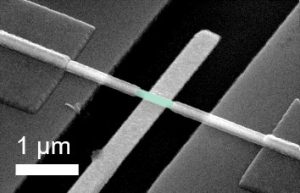To enhance the resilience of superconducting circuits against environmental noise, we are focusing on the quest of robust protected qubits. We want to make use of the fermionic degree of freedom of the Andreev states that have long been overlooked in Josephson circuits.
Up to now, we have explored Andreev physics in superconducting weak links enclosed in low impedance circuits in which case the superconducting phase difference φ can be considered as a classical parameter. When increasing the impedance of the environment, the phase φ acquires significant quantum fluctuations. We predict that in this limit the fermionic degree of freedom of the Andreev levels combines with the bosonic degree of freedom of the circuit’s electromagnetic modes, resulting in a hybrid circuit with intrinsic protection against relaxation and dephasing.Our goal is to explore, both theoretically and experimentally, this crossover and assess the coherent properties of this new superconducting circuit as a qubit.
Related references from other groups:
A. Gyenis et al., “Moving beyond the Transmon: Noise-Protected Superconducting Quantum Circuits”, PRX Quantum 2, 030101 (2021), arXiv:2106.10296.
B. Douçot and L. B. Ioffe, “Physical implementation of protected qubits”, Rep. Prog. Phys. 75, 072001, (2012).
Konstantin Kalashnikov et al., “Bifluxon: Fluxon-Parity-Protected Superconducting Qubit”, PRX Quantum 1, 010307 (2020), arXiv:1910.03769.
Peter Brooks, Alexei Kitaev, and John Preskill, “Protected gates for superconducting qubits”, Phys. Rev. A 87, 052306 (2013), arXiv:1302.4122.
W. C. Smith et al., “Superconducting circuit protected by two Cooper-pair tunneling”, NPJ Quantum Inf. 6, 8 (2020), arXiv:1905.01206.
W. C. Smith et al., “Magnifying quantum phase fluctuations with Cooper-pair pairing”, PRX 12, 021002 (2022), arxiv: 2010.15488.




